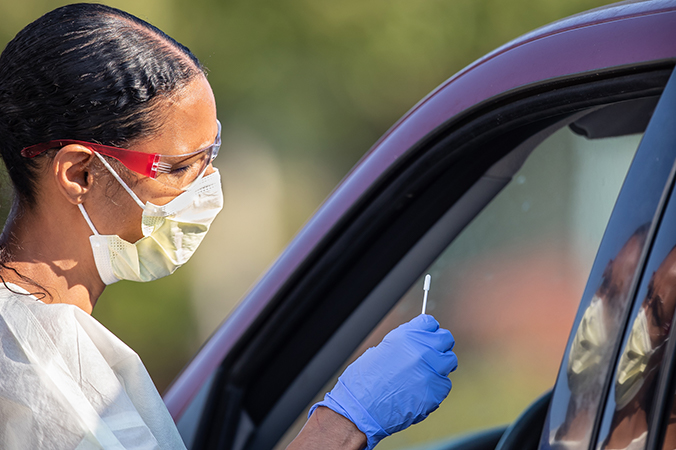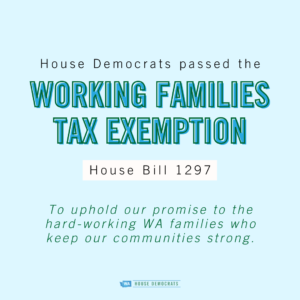Washington’s Recovery Begins With Community
House Democrats are on step three of their plan to provide help to Washington’s families and businesses who have struggled the most during the pandemic. This plan is built around supporting people hit hardest by the pandemic. It prioritizes the needs of Black, Brown, Indigenous, and low-income communities that have suffered disproportionate impacts during the pandemic by threading racial equity in each step and reflecting the input of trusted community organizations who are at the center of this work.
- Step One: $2.2 billion in federal funds for small business grants, vaccine distribution, contract tracing, testing, rental assistance, child care grants, immigrant relief funds, TANF, disaster cash assistance, and food assistance programs.
- Step Two: Changing existing laws and policies to give working families a break by passing the Working Families Tax Credit (House Bill 1297) and the Fair Start for Kids Act (HB 1213), two policies that provide long-term support and support a recovery well past COVID-19.
- Step Three: The “Washington Recovery Budget” that utilizes state and federal funds to invests in food, shelter, and health. We support economic recovery, housing, small businesses, schools, behavioral health, substance use disorder treatment, vaccines, helping undocumented families, frontline workers, child care, and digital equity.
What the plan does

Addressing the pandemic health needs equitably and fairly
- Roll out COVID vaccines, contact tracing and testing across the state and work with community partners to make sure public health is delivered equitably ($618 million in Step One and $1.185 billion in Step Three).
- Establish long-term funding for public health system ($100 million for local public health districts & regions in Step Three)
- Increasing primary care provider rates and ensure care through federally qualified health centers, rural health centers, and free clinics for uninsured and underinsured individuals

Helping our neighbors who are struggling the most
- Food assistance programs including farmers to families food boxes, farm to school programs, emergency food assistance programs, food infrastructure and market access, all to keep the food security network secure even after the pandemic.
- Funding the Fair Start for Kids Act, providing child care grants and supporting providers for language access and navigators.
- Immigrant relief funds that provide unemployment assistance to undocumented workers and families that are vital to their communities, often serving as front-line and essential workers ($65 million in Step One and $340 million in Step Three)
- Addressing how the pandemic exposed just how many families struggle with connectivity and digital needs, providing student and child care connectivity, statewide digital navigators, supporting broadband.

Economic support that reflects needs in local communities
- Small business grants that help those small businesses in local communities that sacrificed during the pandemic ($240 million in Step One and $250 million in Step Three)
- Unemployment insurance rate cuts ($600 million in Step Three and $1.7 billion from SB 5061)
- Rental relief to pay the back rent for families struggling during the pandemic ($1.07 billion in Step Three and $325 million in Step One, for about $1.4 billion).
- Supporting community providers, through grants and rate increases, increasing substance use disorder treatment and response, and funding the 988 national suicide prevention and behavioral health crisis hotline.
Step Three: The Washington Recovery Budget
- $1.185 billion for COVID-19 vaccines, contact tracing and testing.
- $100 million for local public health districts and regions.
- $94 million for primary care provider rate increases.
- $35 million for uninsured and underinsured care through federally qualified health centers, rural health centers, and free clinics.
- $11 million for school nurses.
- $1.07 billion for rental assistance to continue the state goal of paying the back rent accrued during the governor’s eviction moratorium. Combined with the $325 million allocated in the Step One for Community and Economic Recovery bill (HB 1368) passed by the Legislature in February, that totals nearly $1.4 billion in rental relief this year.
- $600 million for unemployment insurance tax rate cuts and $250 million in small business grants.
- $166.6 million in mortgage assistance through the ARPA Homeowner Assistance Fund.
- $140.8 million in food assistance programs.
- $121.6 million in state housing/homelessness assistance.
- $37.63 million to increase TANF grants and $26 million to extend TANF benefits.
- A $26.5 million increase to the Housing and Essential Needs Program, with the goal of serving an estimated 1,700 people who qualify for the program but are waiting for the program to receive more funding.
- $26.2 million increase for the Emergency Cash Assistance program.
- $13 million for foreclosure assistance.
- $340 million for immigrant relief funds that provide unemployment assistance to undocumented workers and families who are vital to their communities, often serving as front-line and essential workers.
- $415 million for a temporary rate increase to long-term care and providers for individuals with developmental disabilities.
- $22 million to fund the Office of Independent Investigations.
- $400 million in child care grants and supporting providers for language access and navigators.
- $90 million for Working Connections Child Care co-pay reductions.
- $96.7 million to fund beds with community-based providers to replace Western State Hospital wards that will be closed.
- $90 million to improve the state’s suicide and behavioral health crisis response system through HB 1477, implementing the 988 national suicide prevention and mental health crisis hotline.
- $69.38 million for substance use disorder treatment and response.
- $53 million for additional special education funding.
- $52.5 million for additional counselors in high-poverty schools.
- $8.9 million to cover school lunch copays.
- Continuing our historic investments with the Workforce Education Investment Act, fully funding the Washington College Grant, and maintaining support for higher education institutions.
- $15.9 million for Guided Pathways.
- $14 million in higher education emergency assistance grants.
- $2.3 million for the UW Medical School and $5.9 million for the WSU Medical School.
- $33 million for student and child care connectivity.
- $7.5 million for statewide digital navigators.
- $1.3 million for grants to support broadband and digital equity planning.
- $1.5 million to fully fund the State Broadband Office and a digital equity forum.
Step Two: State Policies to Promote Greater Financial Stability
Step One for Washington’s Community and Economic Recovery
House and Senate Democrats passed this first step in the House and Senate plan for Washington’s community and economic recovery, starting with the allocation of $2.2 billion in federal funds to provide assistance to Washington families and businesses who have been most impacted by the COVID-19 pandemic. The proposal will ease the financial hardship of struggling renters, small restaurants and other neighborhood businesses, school districts, uninsured and underinsured individuals, and Black and Brown communities, which have been disproportionately hurt during the pandemic. It provides:
- $240 million in small business grants
- $714 million for school district support to address learning loss
- $618 million for vaccine distribution, contact tracing, and testing with an emphasis on vaccinating individuals needed for school re-opening and ensuring that outreach is accessible, culturally and linguistically appropriate, and includes community-driven partnerships and strategies
- $325 million for rental assistance and $5 million for rental and foreclosure assistance
- $4.7 million in food assistance programs, and $26.3 million in block grants for hunger relief organizations
- $50 million for child care grants and incentives, prioritizing providers in child care deserts and supporting racial equity across the state
- $65 million for the Immigrant Relief Fund for those people left out of federal stimulus payments
- $9 million for TANF and $12 million in Disaster Cash Assistance







